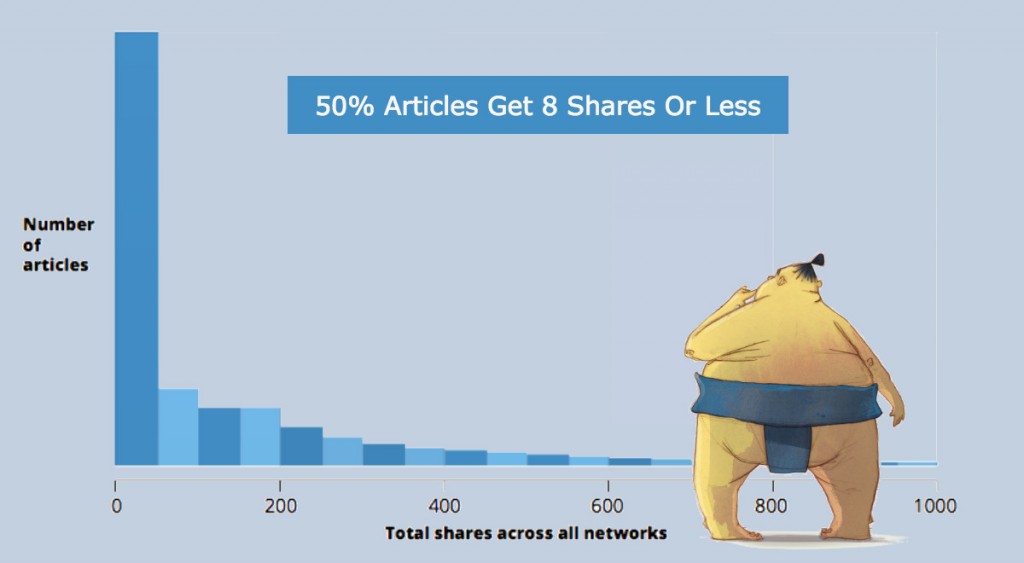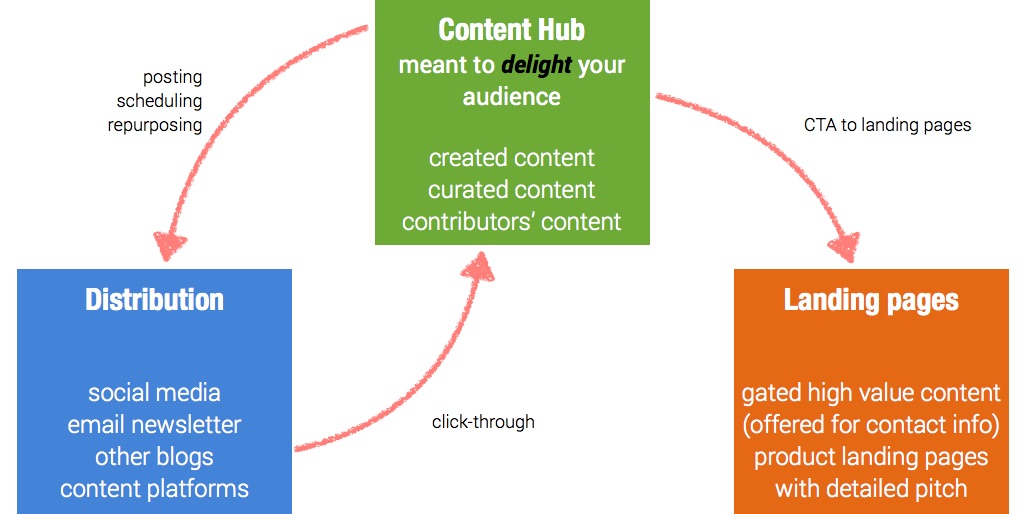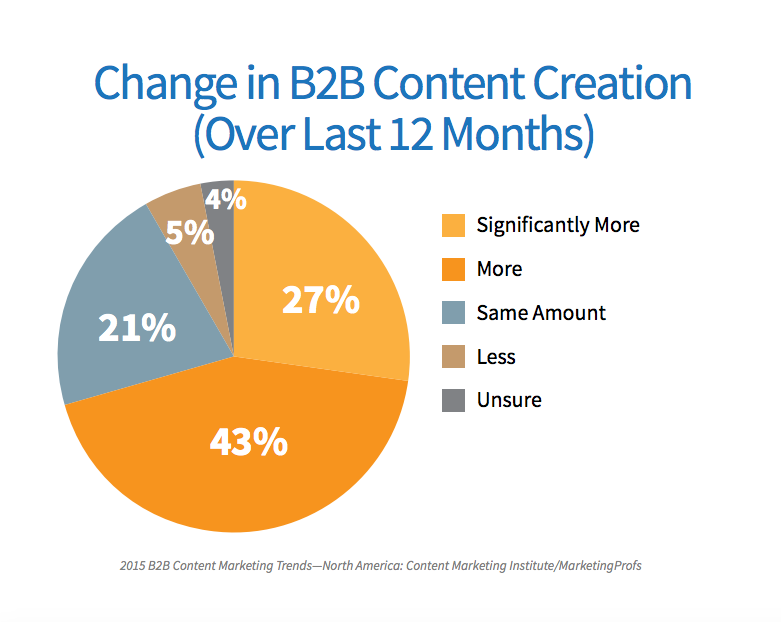
Content production is a challenge that has dominated the content marketing space for a while now, with 54% of B2B marketers continuing to cite the creation of engaging content as their #1 content marketing challenge for 2016.
Today, 80% of marketers create content, yet only 30% report their strategies as being effective. While it is a necessary and complex practice to master, it’s certainly not the only reason why 70% of marketers are failing at content marketing. Producing engaging content is a start, but it’s not enough to generate ROI (traffic, shares, leads, revenue) all on its own.
Let’s take a look at why focusing all your efforts on producing compelling content is not enough to succeed.
Why producing engaging content is not enough
It’s never been enough
Content production by itself has never been enough to begin with. Taking the approach of “Build it and they will come” is a common content marketing misconception that many marketers fall victim to. Even before the days of content shock (yes, it’s hard for us to remember them too) you had to at the very least promote your content via sharing or email.
If you think you can simply hit publish and move on after creating your piece of content, chances are you’ll fall into the 50% of articles that get 8 shares or less.

At the very least, you need to promote your content via sharing or email.
And most companies know that success comes from a combination of best practices:

Yet they still don’t use them:

So why do marketers produce content today? Because everyone else is doing it. But just because something is popular, common or important doesn’t automatically mean that it’s working…
And even more now with content shock
With everyone now doing content, it’s becoming harder than than ever before to cut through the noise and grab the attention of your desired audience.
According to CMI’s latest report, over the last 12 months alone, 70% of B2B marketers from companies of all sizes and across all levels of effectiveness are creating more content.
2 million blog posts are being written and published, every day.
That’s 3 times the number of babies that are born every day.
That’s a lot of content. And this explosion in content production has led to the very real dilemma of content shock, whereby everyone is now competing harder than ever before for the same attention. This means that it’s going to take more than just stepping up your content production efforts if you want to succeed.
Case in point? Only 9% of B2B marketers today consider their content marketing efforts to be effective, which means that all of this content production doesn’t seem to be working.
Not only does your content need to compete harder for attention, but it also needs to generate action from your audience.
Your content needs to be more than engaging: it needs to convert
Content marketing is about publishing and distributing content that moves potential customers down your funnel. In other words, content marketing should be about content that converts. If you have great content that people love and share but that doesn’t bring people closer to making a buying decision, you will still fail as a marketer.
Lead generation is a key objective for most marketers, with 83% reporting it to be the #1 goal of their content marketing. Ultimately, the goal of your content should be to convert your visitors into subscribers, prospects, or customers.
Make sure 100% of your content is optimized for conversion: Organize your content framework around the 3 pillars of conversion:

Remember the 80/20 rule: Only 20% of your content should be about your product or brand. The remaining 80% should be geared towards educating and providing value for your audience.
You can’t bet all you have on a few epic pieces of content: In the words of Marcus Sheridan, “Some ‘just ok’ content that is published will crush ‘awesome content’ that never gets published. Basically, you need to do more to get more. Success with content marketing doesn’t come from taking days or weeks to create a few strong long-form pieces of content (whitepapers, eBooks, etc.) and relying on them to generate massive amount of leads every month or quarter. Publishing more regular content generates more leads overall and is more impactful than creating a few pieces of content every once in a while.
Never leave home without a CTA: Every piece of content should convert provided you offer the right call to action. Of course, a first-time visitor won’t be likely to click on “talk to sales” immediately after reading a high-level thought leadership piece from your blog. But would you be able to say that this piece of content was awesome even if nobody subscribed to your email list to receive more similar content? Or if nobody bothered to download a gated white paper expanding on this topic?
We know this based on our own experience here at Scoop.it. Using our tool, we were able to identify a great post that generated a ton of views and traffic, yet delivered 0 leads:
 Even though it was a good post that attracted views, because it lacked a CTA, it ended up being an ineffective piece of content that was unable to convert.
Even though it was a good post that attracted views, because it lacked a CTA, it ended up being an ineffective piece of content that was unable to convert.
Now you know the reasons for why simply creating good content is not enough. Even if it’s the most engaging, compelling piece of written work you’ve ever created, if it’s not serving the overall business goals it was intended for, then it’s not working. This requires taking a step back and looking at the bigger picture…
Consider content marketing = content + marketing
A good content marketing strategy takes into account the marketing component of things. And marketing needs KPIs with which to measure results.
Enter the content marketing lifecycle:
While it may seem like a lot of work, maximizing your efforts in every phase of the content marketing lifecycle is the formula for content marketing success.
- Strategize: a good content marketing strategy is about establishing a clear, directional path for your content to follow that aligns with your business goals and objectives.
- Plan: establishing a plan for your content marketing strategy is a critical component for guiding your content creation efforts and keeping them focused on your business goals and objectives.
- Produce: publishing good content isn’t enough if you aren’t doing it regularly. You should aim to create relevant, high-value content for your audience- if you don’t have the time or resources, use lean content marketing methods to scale your efforts.
- Promote: promoting your content (across your social channels, by email, etc.) is critical if you want it to get in front of the audience you intended it for. Without investing in distribution tactics to maximize visibility, your content will go unseen and your efforts will have been wasted.
- Analyze: analyzing the results of your efforts is critical for understanding the effectiveness of your efforts so that you can continually improve. Using a simple content marketing analytics framework to measure ROI, you can understand the performance of your content to ensure you stay on track to reaching your business goals.
- Amplify: after you hit publish, you need to continue to share your content to maximize its visibility and ensure it reaches the largest audience possible.
By viewing the full content marketing lifecycle and optimizing your efforts in every phase, you can generate a lot of ROI. Better yet, focusing on the other phases of this cycle will also inform your content creation process, and help you figure out where and how much fuel you should be putting into your content marketing machine to generate maximum results.
This may seem like a lot to take in. Content marketing is unfortunately more complicated today than it has ever been. Which is why it’s more important than ever before to leverage smart intelligence to help maximize your efforts in every phase.
How technology will change the game
If you want to be part of the 30% of marketers who find their content marketing strategies to be effective, you’re going to need to implement a set of best practices not only to be able to produce great content consistently, but also to strategize, plan, promote, analyze and amplify all of your content marketing.
Overwhelming? Yes, indeed. Even with a clear vision of this cycle and a set of techniques to help you be lean each step of the way, it’s still going to be a (big) piece of work and a greater investment than you were used to if you just produced content.
So we surveyed hundreds of marketers and dozens of marketing influencers to find out how they felt about this and what they needed to become more efficient. The results were unanimous:
Marketers today need and want more insight into what actions they should prioritize to drive more results from the content they are building and the content they already have.
That’s where intelligence comes in. Historically, marketing technology has made it easier and easier for marketers to automate simple tasks. Like helping you schedule your social media messages. Or finding great content to share with your audience. Or planning your content marketing with an editorial calendar. But the landscape has gotten so crowded over the years that it is now a challenge of its own to choose, implement and maintain a solution for your team. Besides, no matter how long and how good you are at using these tools, if you don’t know on which actions you should focus on or if you’re unable to measure the return on investment for each of them, how good does it do to your productivity?
Technology should now be able to identify areas of improvement for you, so you can focus on making them happen rather than finding what they are.
That’s called content marketing intelligence. And marketers are going to have to leverage technological innovations in order to become smarter about the content they create, faster at managing their content operations and stronger at demonstrating value to the rest of their organization. The future of content marketing is bright thanks to the increasingly important role of technology. If you’re curious to learn more about what the next five years holds for content marketing and the role technology will play in helping to shape it, check out this article on our vision for the content marketer of the future.
Conclusion
If you want to succeed, you have to take a step back and look at the big picture of the full content marketing lifecycle. By leveraging technology and intelligence, you can optimize your efforts in every phase to ensure you reach your goals. And deadlines.
If you want to get 30 effective techniques to master content marketing along with valuable insights from 10+ influencers like Mark Schaefer, Rebecca Lieb, Lee Odden, Jason Miller or Ian Cleary, download our free eBook now!
Image by Gunther Hagleitner




